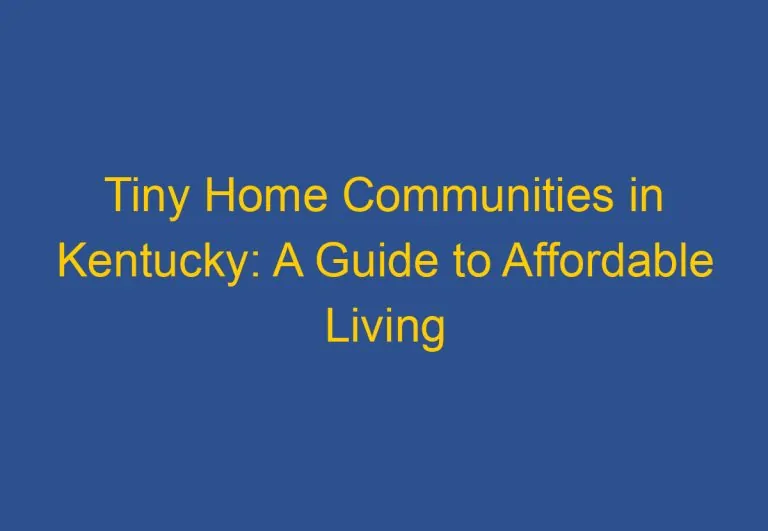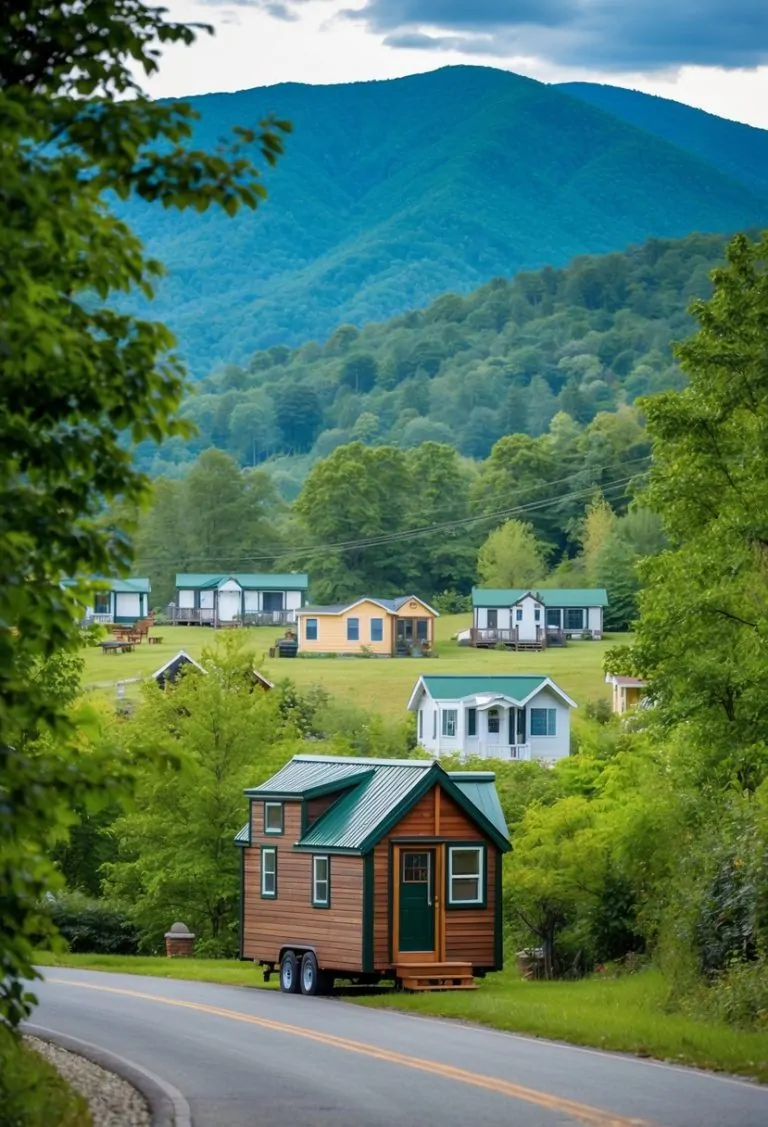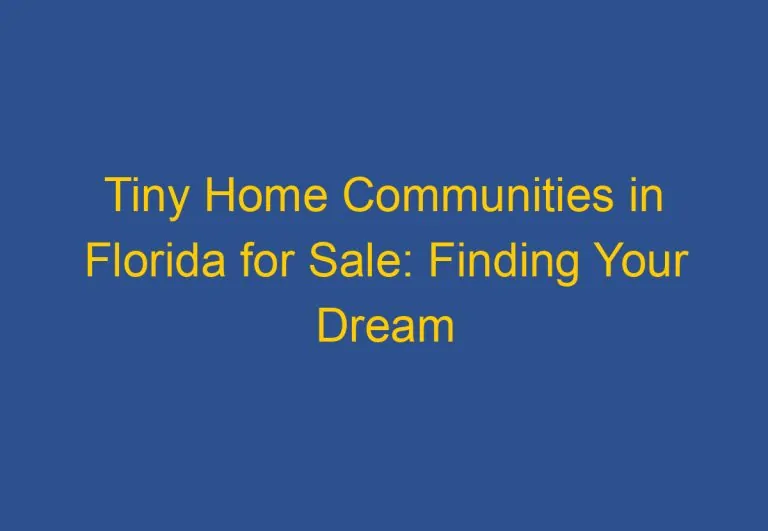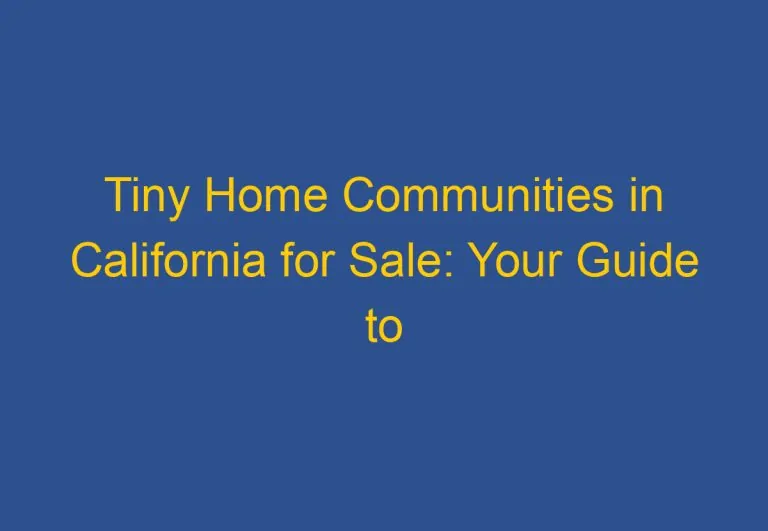What Counties in Florida Allow Tiny Houses: A Comprehensive Guide
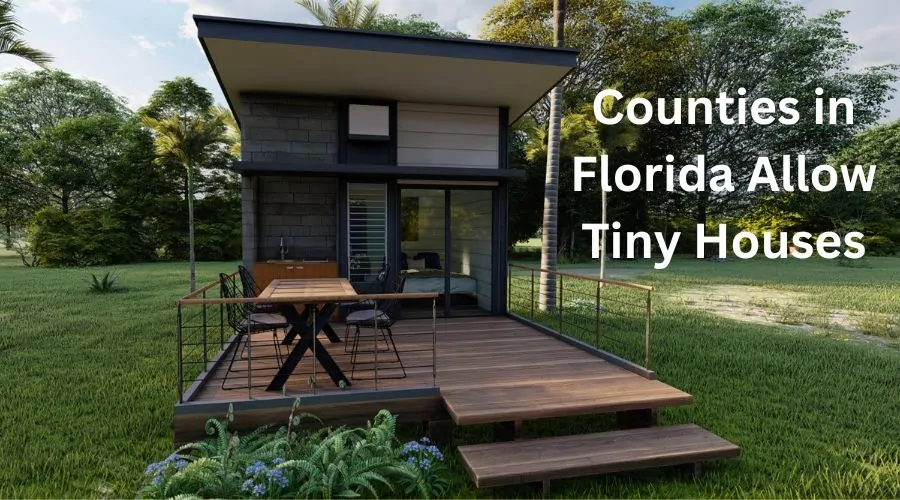
If you’re interested in living in a tiny house in Florida, it’s important to know which counties allow them. While Florida is generally accepting of tiny homes, each county has their own specific rules and regulations. In this article, we’ll provide you with a comprehensive guide on what counties in Florida allow tiny houses.
Firstly, it’s important to note that not all counties in Florida allow tiny homes. Some counties may have restrictions on where you can park your tiny home or how you can build it.
For example, Escambia County allows tiny homes on wheels as long as they are parked on a lot with a primary dwelling and meet certain requirements.
On the other hand, Hillsborough County allows tiny homes as ADUs with a maximum size of 1,000 square feet.
If you’re planning on building or purchasing a tiny home in Florida, it’s important to research the specific rules and regulations in the county you’re interested in.
In the following sections, we’ll provide you with more information on what each county requires and how you can ensure that you’re following all the necessary guidelines.
Florida’s Stance on Tiny Houses
Florida has become a popular destination for tiny house enthusiasts due to its warm climate and relaxed lifestyle. However, before you start building your tiny home, it is important to understand the rules and regulations that govern the construction and placement of these homes in Florida.
Statewide laws regarding tiny homes in Florida are currently limited, leaving the regulation of tiny homes up to local jurisdictions.
This means that each county may have its own rules and regulations regarding the construction and placement of tiny homes.
Zoning regulations are often the most important factor to consider when building a tiny home in Florida. Zoning laws dictate what type of structures can be built in certain areas and how they can be used. Research the zoning requirements in your area before beginning construction on your tiny home.
Some counties in Florida have embraced the tiny house movement and have created specific rules and regulations for tiny homes.
For example, Brevard County has an online application process to register a tiny home on wheels as a primary residence, and a tiny home community in Cocoa has easily thrived.
However, other counties may have more restrictive regulations, such as minimum square footage requirements or limitations on where tiny homes can be placed.
Consult with local authorities and zoning officials before beginning construction on your tiny home to ensure that you are in compliance with all applicable rules and regulations. By doing so, you can avoid costly fines and legal issues down the road.
In summary, while Florida does not have statewide laws regulating tiny homes, understand the rules and regulations of your local jurisdiction before beginning construction on your tiny home.
Zoning regulations are often the most important factor to consider, and it is important to consult with local authorities to ensure compliance with all applicable rules and regulations.
Counties in Florida Allow Tiny Houses
Florida is generally very accepting of the tiny home community, however, regulations for tiny houses in Florida vary from city to city and county to county.
Before building or traveling with a tiny house in Florida, research the local regulations and zoning codes. Here are some of the counties in Florida that allow tiny houses:
- St. Petersburg: In 2018, the City Council of St. Petersburg approved an ordinance allowing tiny houses on wheels as accessory dwelling units (ADUs) in the backyards of existing homes. The maximum size of the tiny house is 375 square feet.
- Sarasota County: In 2016, Sarasota County approved new zoning regulations that allow for accessory dwelling units (ADUs), including tiny houses. The maximum size of the tiny house is 750 square feet.
- Pasco County: In 2017, Pasco County approved new zoning regulations that allow for tiny houses on wheels as ADUs. The maximum size of the tiny house is 400 square feet.
- Dixie County: In 2018, the County Commission of Dixie County approved an ordinance allowing tiny houses on wheels as ADUs. The maximum size of the tiny house is 400 square feet.
- Orange County: In 2018, Orange County approved new zoning regulations that allow for tiny houses on wheels as ADUs. The maximum size of the tiny house is 500 square feet.
- Columbia County: In 2019, Columbia County approved new zoning regulations that allow for tiny houses on wheels as ADUs. The maximum size of the tiny house is 400 square feet.
- Wakulla County: In 2020, Wakulla County approved new zoning regulations that allow for tiny houses on wheels as ADUs. The maximum size of the tiny house is 400 square feet.
- Alachua County: In 2021, Alachua County approved new zoning regulations that allow for tiny houses on wheels as ADUs. The maximum size of the tiny house is 400 square feet.
- St. Johns County: In 2021, St. Johns County approved new zoning regulations that allow for tiny houses on wheels as ADUs. The maximum size of the tiny house is 400 square feet.
- Brevard County: In 2021, Brevard County approved new zoning regulations that allow for tiny houses on wheels as ADUs. The maximum size of the tiny house is 400 square feet.
- Pinellas County: In 2021, Pinellas County approved new zoning regulations that allow for tiny houses on wheels as ADUs. The maximum size of the tiny house is 500 square feet.
Regulations and zoning codes can change over time, so it is always best to do your research before building or traveling with a tiny house in Florida.
Wakulla county tiny home regulations
As of now, Wakulla County regulations stipulate that residential dwellings must be at least 600 square feet in size. However, there have been exceptions where residential structures smaller than 600 square feet have been permitted within the county.
Building and Land Use Regulations
When it comes to building and land use regulations for tiny houses in Florida, it’s important to know that each county has its own set of rules and guidelines. Some counties may have specific regulations for tiny homes, while others may not have any at all. Here are some things to keep in mind:
Building Codes and Permits
In Florida, building codes and permits are regulated at the county level. This means that each county has its own building code and permit requirements that must be followed. Some counties may require that you obtain a building permit before constructing your tiny home, while others may not. It’s important to check with your local building officials to determine what permits and codes you need to follow.
Land Use Regulations
Land use regulations are another important consideration when it comes to building a tiny home in Florida. Some counties may have zoning ordinances that prohibit tiny homes or restrict where they can be located. Other counties may allow tiny homes as accessory dwelling units (ADUs) or as part of a planned development. It’s important to check with your local zoning officials to determine what land use regulations apply to your tiny home.
Department of Motor Vehicles
If you plan to build a tiny home on wheels in Florida, you may need to register it with the Department of Motor Vehicles (DMV). This is because tiny homes on wheels are considered recreational vehicles (RVs) under Florida law. You will need to obtain a title and registration for your tiny home from the DMV before you can legally drive it on public roads.
Overall, building and land use regulations for tiny homes in Florida can be complex and vary widely from county to county. It’s important to do your research and consult with local officials to ensure that you are following all the necessary regulations and guidelines.
Tiny Houses as Permanent Residences
If you are looking to make a tiny house your permanent residence, it is important to know the rules and regulations that apply in the county you plan to live in. In Florida, tiny houses are considered to be dwellings of conventional size if they have more than 400 square feet of floor area, excluding lofts.
When it comes to building a tiny house on a permanent foundation, some counties in Florida may have specific requirements. For example, Sarasota County requires that tiny houses on a permanent foundation must meet the same building codes as traditional homes. It is important to check with the county you plan to live in to ensure that your tiny house meets all the necessary building codes and regulations.
In terms of property rights, owning a tiny house on a permanent foundation is similar to owning a traditional home. You will have the same property rights and responsibilities as any other homeowner, including the ability to sell your property or pass it on to your heirs.
As a primary residence, a tiny house can be a great way to downsize and simplify your life. However, consider the practicalities of living in a small space, such as storage, utilities, and zoning restrictions. To ensure that your tiny house is designed and built to meet your specific needs and lifestyle.
Overall, if you are considering a tiny house as a permanent residence in Florida, do your research and ensure that you are following all the necessary rules and regulations. With the right planning and preparation, a tiny house can be a comfortable and affordable way to live in the Sunshine State.
Tiny House Communities and RV Parks
If you’re looking for a place to park your tiny home in Florida, you have a few options. Tiny house communities and RV parks are two of the most popular choices.
Tiny house communities are neighborhoods specifically designed for tiny homes. They often have shared amenities like laundry facilities, community gardens, and recreation spaces. In Florida, there are several tiny house communities that allow residents to park their tiny homes. Some of the most popular ones include Circle Pond Tiny Community, The Outpost Park and Community, Gracious Tiny House Park, and Braveheart Properties.
RV parks are another option for parking your tiny home in Florida. Many RV parks allow tiny homes, and they often have amenities like electrical hookups, water and sewer connections, and laundry facilities. Some of the most popular RV parks in Florida include Christmas RV Park and Lost Lake RV Park.
When choosing a tiny house community or RV park, it’s important to do your research. Make sure the community or park allows tiny homes and that their rules and regulations align with your needs. You should also consider factors like location, amenities, and cost.
For Florida tiny house enthusiasts, tiny house communities and RV parks offer a great way to live a minimalist lifestyle while still enjoying the comforts of home. Whether you’re looking for a permanent residence or a vacation spot, there are plenty of options to choose from in Florida.
Renting and Airbnb
If you’re interested in experiencing the tiny house lifestyle in Florida, renting a tiny house on Airbnb is a great option. There are many tiny houses available for rent on the platform, ranging from shotgun tiny houses in Tampa to lakefront tiny houses on wheels in Orlando to foundation tiny homes steps from Panama City Beach.
When renting a tiny house on Airbnb, it’s important to read the listing carefully to ensure that it meets your needs and expectations. Make sure to check the amenities provided, such as kitchen appliances, heating and cooling systems, and bathroom facilities. Additionally, be aware of any rules or restrictions that the host may have, such as no pets or no smoking.
Renting a tiny house on Airbnb can be a great way to experience the tiny house lifestyle without committing to building or buying your own tiny home. It can also be a cost-effective way to travel, as many tiny houses on Airbnb are priced similarly to traditional hotel rooms.
However, it’s important to note that not all tiny houses on Airbnb are legal. Before booking a tiny house on Airbnb, make sure to check with the county where the tiny house is located to ensure that it is allowed to be used as a rental property. Additionally, be aware that some counties may have specific regulations regarding short-term rentals, so it’s important to do your research before booking.
Overall, renting a tiny house on Airbnb can be a fun and unique way to experience the tiny house lifestyle in Florida. Just make sure to do your due diligence before booking to ensure a safe and legal stay.
Insurance and Legal Considerations
When it comes to tiny houses, there are several insurance and legal considerations that you need to keep in mind. Here are some things to consider:
Insurance
Ensure that your tiny house is properly insured. While some insurance companies do offer coverage for tiny homes, others do not. Therefore, do your research and find an insurance company that offers coverage for tiny homes.
Home Insurance
If you plan on living in your tiny home full-time, you will need to have home insurance. However, not all insurance companies offer coverage for tiny homes. Therefore, to find an insurance company that offers coverage for tiny homes.
Due Diligence
Before purchasing a tiny home, do your due diligence and research the laws and regulations in the county you plan on living in. This will help you avoid any fines or legal issues down the road.
Fines
If you do not comply with the laws and regulations in your county, you may be subject to fines. Therefore, to ensure that your tiny home is built to code and complies with all local laws and regulations.
Land Use Attorney
If you are unsure about the laws and regulations in your county, it may be a good idea to consult with a land use attorney. They can help you navigate the legal landscape and ensure that your tiny home is compliant with all local laws and regulations.
Overall, do your research and ensure that your tiny home is properly insured and compliant with all local laws and regulations. This will help you avoid any fines or legal issues down the road.
Tiny House Builders in Florida
If you’re looking to build a tiny home in Florida, you’re in luck. There are plenty of tiny house builders in the state to choose from. Here are a few that you should know:
Sanctuary Tiny Homes
Sanctuary Tiny Homes is a custom tiny home builder based in Florida. They offer custom builds, shells, trailers, and design consultations for those who need help during the process of designing, planning, and building their tiny home. Their tiny homes are beautiful and environmentally friendly, and they are custom designed for each user’s unique situation. Prices start at $54,000.
Cornerstone Tiny Homes
Cornerstone Tiny Homes is another custom tiny home builder based in Florida. They offer a range of tiny home models to choose from, as well as custom builds. They also offer financing options for those who need it. Their tiny homes are built to last, and they are designed to be both functional and beautiful.
Tiny Home Builders
Tiny Home Builders is a company that offers tiny home plans, workshops, and resources for those who want to build their own tiny home. They are based in Florida, and they have been in business since 2009. They offer a range of plans to choose from, as well as workshops that teach you how to build your own tiny home.
Tampa Bay Tiny Homes
Tampa Bay Tiny Homes is a custom tiny home builder based in Florida. They offer custom builds, shells, and trailers, as well as design consultations. Their tiny homes are designed to be both functional and beautiful, and they are built to last. They also offer financing options for those who need it.
Other Tiny House Builders in Florida
In addition to the builders listed above, there are many other tiny house builders in Florida to choose from. Some of these include:
- Modern Tiny Living
- Tiny House Nation
- Tumbleweed Tiny House Company
- Incredible Tiny Homes
- Brevard Tiny House Company
When choosing a tiny house builder in Florida, it’s important to do your research and choose a builder that has a good reputation and a track record of building quality tiny homes. You should also consider factors such as price, design, and customization options. With so many builders to choose from, you’re sure to find one that meets your needs and budget.
Tiny Houses in Other States
If you’re interested in tiny houses, you may be curious about where else in the United States they are allowed. Here’s a brief overview of some other states and their regulations:
California
California is known for being one of the most progressive states when it comes to tiny houses. In fact, there are several tiny house communities throughout the state. However, regulations vary by county, so it’s important to do your research before building or parking a tiny house in California.
Colorado
Colorado is another state that is friendly to tiny houses. However, regulations vary by city and county, so it’s important to do your research before building or parking a tiny house in Colorado. Some cities, such as Durango, have specific regulations for tiny houses, while others do not.
Maine
Maine is a state that has been making strides in the tiny house movement. In fact, there are several tiny house communities throughout the state. However, regulations vary by town and city, so it’s important to do your research before building or parking a tiny house in Maine.
North Carolina
North Carolina is a state that is becoming more and more friendly to tiny houses. In fact, there are several tiny house communities throughout the state. However, regulations vary by county, so it’s important to do your research before building or parking a tiny house in North Carolina.
Tennessee
Tennessee is a state that is known for being friendly to tiny houses. In fact, there are several tiny house communities throughout the state. However, regulations vary by city and county, so it’s important to do your research before building or parking a tiny house in Tennessee. Some cities, such as Nashville, have specific regulations for tiny houses, while others do not.
The Influence of the Pandemic
The pandemic has had a significant impact on the tiny house movement in Florida.
Many people have been forced to reconsider their living arrangements due to the economic downturn caused by the pandemic. This has led to an increased interest in tiny homes as a more affordable and sustainable housing option.
Additionally, the pandemic has led to a surge in remote work. With many people no longer tied to a physical office, they have the freedom to live wherever they choose.
This has led to an increased interest in tiny homes, as they offer a way to live a more minimalist lifestyle while still enjoying the benefits of homeownership.
However, the pandemic has also led to some challenges for tiny home owners in Florida. Many counties have seen an increase in short-term rentals, as people look for affordable vacation options close to home.
This has led to increased scrutiny from local governments, as they try to regulate the use of tiny homes as vacation rentals.
Despite these challenges, the pandemic has also led to some positive changes for the tiny house movement in Florida.
Many communities have recognized the benefits of tiny homes as a way to provide affordable housing options for their residents.
This has led to an increase in the number of counties that allow tiny homes, as local governments look for ways to support their communities during these challenging times.
Overall, the pandemic has had both positive and negative impacts on the tiny house movement in Florida.
While it has led to increased interest in tiny homes as a more affordable and sustainable housing option, it has also led to increased scrutiny from local governments.
However, with more and more counties recognizing the benefits of tiny homes, it is likely that we will continue to see growth in this movement in the years to come.
Environmental Impact and Sustainability
When it comes to tiny houses, one of the biggest advantages is their environmental impact. These small homes require less energy to heat and cool, and they often use sustainable materials in their construction.
Additionally, many tiny house owners choose to incorporate renewable energy sources like solar panels into their homes.
If you’re interested in living a more environmentally friendly lifestyle, a tiny house could be a great option for you.
However, it’s important to note that not all counties in Florida have the same regulations when it comes to sustainable building practices.
For example, Sarasota County has a Green Building Program that encourages sustainable construction practices.
This program provides incentives for builders who use sustainable materials and design features, and it requires all new construction to meet certain energy efficiency standards.
Petersburg also has a focus on sustainability, with a goal to reduce greenhouse gas emissions by 80% by 2050.
The city has implemented a number of programs and initiatives to achieve this goal, including a solar co-op program and a green building certification program.
Orange County also has a focus on sustainability, with a Green Building Code that requires all new construction to meet certain energy efficiency standards.
Additionally, the county has a number of programs and initiatives to promote renewable energy and sustainable living.
If you’re interested in building a tiny house with a focus on sustainability, it’s important to research the regulations and programs in your specific county.
By doing so, you can ensure that your home is not only environmentally friendly, but also compliant with local building codes and regulations.
Trends and Popularity
Tiny homes have been gaining popularity in recent years, and Florida is no exception.
As more people seek affordable and sustainable housing options, the tiny home industry has grown to meet the demand.
According to the Tiny Home Industry Association, there are currently over 10,000 tiny homes in the United States, with that number expected to continue to rise.
In Florida, the International Residential Code (IRC) governs the construction of tiny homes. While there is no specific size requirement for a home to be considered “tiny,” they typically fall between 100 and 400 square feet.
Additionally, municipalities in Florida may have their own regulations regarding tiny homes, which can vary widely.
Despite some challenges, the tiny home movement is still going strong in Florida.
Many municipalities are beginning to recognize the benefits of tiny homes, such as their affordability and sustainability. As a result, more and more communities are allowing tiny homes to be built and lived in.
If you’re interested in living in a tiny home in Florida, it’s important to do your research and make sure you understand the regulations in your area.
Some counties, such as Sarasota and Pasco, are known for being more open to tiny homes, while others may have more restrictions.
Overall, the tiny home movement in Florida is on the rise, and it’s likely that we’ll continue to see more and more communities embracing this unique and innovative housing option.
Affordable Housing and Tiny Houses
Tiny houses have become an increasingly popular option for affordable housing in Florida.
With the rising cost of living and housing, many people are turning to tiny houses as a way to downsize and save money.
One of the main advantages of tiny houses is their affordability. They can be built for a fraction of the cost of a traditional home, and they require much less maintenance and upkeep.
This makes them an attractive option for people who are looking for an affordable housing solution.
In addition to being affordable, tiny houses are also environmentally friendly. They require much less energy to heat and cool, which can help to reduce your carbon footprint and save you money on energy bills.
Another advantage of tiny houses is their flexibility. They can be built on wheels, which makes them portable and allows you to move them to different locations if needed.
This can be especially useful for people who need to relocate frequently for work or other reasons.
Overall, tiny houses can be a great option for affordable housing in Florida. They offer a number of advantages over traditional homes, including affordability, environmental friendliness, and flexibility. If you are looking for an affordable housing solution, a tiny house may be worth considering.
Safety Standards and Regulations
When it comes to building and living in a tiny house, safety should be your top priority.
Florida has adopted something called “Appendix Q” within its Building Code, which sets forth basic rules for constructing houses that are 400 square feet or less.
However, it’s important to note that tiny house regulations vary by county, so it’s crucial to check with your local jurisdiction before building or moving into a tiny home.
In terms of safety standards, the Florida Building Code requires that tiny houses meet certain standards for electrical, plumbing, and mechanical systems. These standards ensure that your tiny home is safe and functional, and that it meets the same standards as traditional homes.
When it comes to labor, it’s important to work with licensed contractors who are familiar with building tiny homes.
This ensures that your home is built to code and meets all safety standards. Additionally, it’s important to obtain the necessary permits and inspections to ensure that your home is up to code and safe to live in.
Utilities are also an important consideration when building or living in a tiny house.
Depending on where you live, you may need to connect to city water and sewer services, or you may need to install a septic system and well.
It’s important to ensure that your home has access to safe and reliable utilities, and that you comply with all local regulations.
Finally, if you plan to use your tiny house as a park trailer, it’s important to comply with all state and local regulations.
Park trailers are subject to specific safety standards and regulations, and you may need to obtain a permit or license to use your home as a park trailer.
Overall, building and living in a tiny house in Florida can be a great option, but it’s important to ensure that your home meets all safety standards and regulations.
By working with licensed contractors, obtaining the necessary permits and inspections, and complying with all local regulations, you can ensure that your tiny home is safe and functional.
Conclusion
So What Counties in Florida Allow Tiny Houses?
Some counties in Florida that allow tiny houses include Sarasota County, St. Petersburg, and Orange County.
- Miami-Dade County: Miami-Dade County allows the construction, use, and occupancy of “Tiny Homes” as long as the homes are on a permanent foundation and meet all other building and zoning requirements.
- Broward County: Broward County allows the construction, use, and occupancy of “Tiny Homes” as long as the homes are on a permanent foundation and meet all other building and zoning requirements.
- Palm Beach County: Palm Beach County does not have any specific zoning regulations for “Tiny Homes.” However, if you live in a “R-1 Residential District,” you may be able to build a Tiny Home on your property provided it is within the height and setback restrictions allowed in that district.

